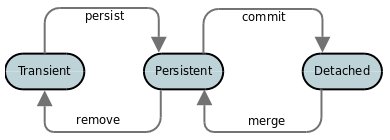
|

|

|

|

|

|

|
|
| DataNucleus AccessPlatform 4.1 Documentation |
|
During the persistence process an object goes through lifecycle changes. Below we demonstrate the primary object lifecycle changes for JPA. With JPA these lifecycles are referred to as "persistence contexts". There are two : transaction (default for JavaEE usage) and extended (default for JavaSE usage). DataNucleus allows control over which to use by specification of the persistence property datanucleus.jpa.persistenceContextType

A newly created object is transient. You then persist it and it becomes persistent. You then commit the transaction and it is detached for use elsewhere in the application, in detached state. You then attach any changes back to persistence and it becomes persistent again. Finally when you delete the object from persistence and commit that transaction it is in transient state.

So a newly created object is transient. You then persist it and it becomes persistent. You then commit the transaction and it remains managed in persistent state. When you close the EntityManager it becomes detached. Finally when you delete the object from persistence and commit that transaction it is in transient state.
When you detach an object (and its graph) either explicitly (using em.detach()) or implicitly via the PersistenceContext above, you need to be careful about which fields are detached. If you detach everything then you can end up with a huge graph that could impact on the performance of your application. On the other hand you need to ensure that you have all fields that you will be needing access to whilst detached. Should you access a field that was not detached an IllegalAccessException is thrown. All fields that are loaded will be detached so make sure you either load all required when retrieving the object using Entity Graphs or you access fields whilst attached (which will load them).
Important : Please note that some people interpret the JPA spec as implying that an object which has a primary key field set to a value as being detached. DataNucleus does not take this point of view, since the only way you can have a detached object is to detach it from persistence (i.e it was once managed/attached). To reinforce our view of things, what state is an object in which has a primitive primary key field ? Using the logic above of these other people any object of such a class would be in detached state (when not managed) since its PK is set. An object that has a PK field set is transient unless it was detached from persistence. Note that you can merge a transient object by setting the persistence property datanucleus.allowAttachOfTransient to true.
Note that DataNucleus does not use the "CascadeType.DETACH" flag explicitly, and instead detaches the fields that are loaded (or marked for eager loading). In addition it allows the user to make use of the FetchPlan extension for controlling the fine details of what is loaded (and hence detached).
JPA provides nothing to determine the lifecycle state of an object. Fortunately DataNucleus does consider this useful, so you can call the following
String state = NucleusJPAHelper.getObjectState(entity); boolean detached = NucleusJPAHelper.isDetached(entity); boolean persistent = NucleusJPAHelper.isPersistent(entity); boolean deleted = NucleusJPAHelper.isDeleted(entity); boolean transactional = NucleusJPAHelper.isTransactional(entity);
When an object is detached it is often useful to know which fields are loaded/dirty. You can do this with the following helper methods
Object[] detachedState = NucleusJPAHelper.getDetachedStateForObject(entity); // detachedState[0] is the identity, detachedState[1] is the version when detached // detachedState[2] is a BitSet for loaded fields // detachedState[3] is a BitSet for dirty fields String[] dirtyFieldNames = NucleusJPAHelper.getDirtyFields(entity, em); String[] loadedFieldNames = NucleusJPAHelper.getLoadedFields(entity, em);